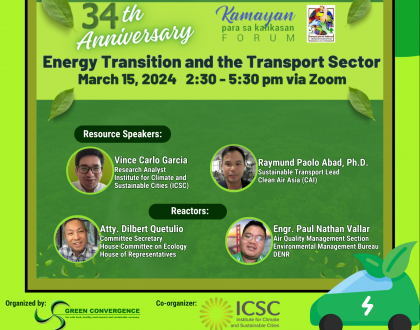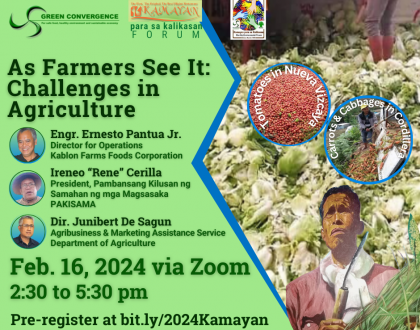Safe Food Manufacturing
I am not sure if you will agree with me that manufacturing might be a broad label for the food production realm or the industry of food production. The word manufacturing evokes factories and mass production every single time. It might not be that, because cottage industries also involve some level of manufacture. So I’d like to propose that we talk about production instead of manufacturing. That is closer to the ideals of small-scale, diverse, intensive agriculture. And that food production really has to do with not only making the food but also making it eventually available to the consumers.
I’d like to think about it in two ways: one is production and the other is on the eater. Most of the things that are discussed in many workshops and events are on the production side. But I keep going back to the notion that “bawat subo ay boto”. We are in an election every day of the year because when we choose what we eat when we make that decision, every 3 times to 5 times a day, we actually make a vote. Each fast-food joint is actually a window into a changing agricultural landscape, like potatoes in the rice terraces, for example.
I’d like us to look at the eater first. How the food reaches the homes is an issue of how manufacturers try to treat their production – trying to keep it stored, to keep it packaged. That dilemma of food producers has a lot to do with what the impacts on the food are. The decision of the buyer is at a single point in time and the decision is made for them if they don’t think ahead. So as an eater, kung bawat subo ay boto, we are obligated to meditate on the source of our food and on the eventual end of the food; so that we think of where it might have come from, where it might end after we eat it, after where our bodies dispose of it.
We also have to meditate on the positioning of our eating in the food chain because we think of the food chain as animals. We think of ourselves at the end of the food chain, when actually it is a food web. And if you meditate on the positioning of our decisions of eating in the food web, we may be able to connect with ourselves better, not only on our
communities and neighborhood but on the community of life, in general.
Many decisions though are individual. It really helps if there are policies that shape behavior. I learned a lot from the tobacco control advocacy. I think it was at this point when I had to say that education has come to mean different things to me. And if it’s argued about, I get very uncomfortable. If you go head to head educating, we are hopelessly at the mercy of large corporations that also educate through their advertising and through other means. It’s in tobacco control that you learn that no amount of education will work if the father smokes and it’s a normal thing. So we have to re-think what is normal. And in praying before meals or in meditating on the source and ends of our meals, maybe that is the time when we can also meditate on what has become normal for us.
The challenge is, in the past decade the illnesses of the planet have moved from infectious diseases to non-communicable diseases (NCD). NCDs, as the World Health Organization (WHO) call them, are basically diseases that spring from lifestyle choices. The major lifestyle choice is, of course, deciding what to eat. Since it’s a 3 times a day activity, or to some it’s five times a day, or a decision to cut it down to 3 or 4, which is an environmental decision as well, that decision has many, many environmental consequences. While each meal is important, it’s also important to think of staples and diets and cuisines.
One of the major works that are considered the bibles of safe production decisions, to-eat-what-type-of-food philosophy, is the omnivore’s dilemma which is the ecological history of our meals. So even if you make each decision count and even if your meals are ecological, if the cuisine itself has been lost, then that decision is all the harder. The decision becomes more and more difficult because you are not following a staple, you are not following a cuisine. It’s much easier if you follow a cuisine, then you treat yourself to high valuable added types of food once in a while. We also can’t just let go off of very well made, high value types of food that most people cannot afford. But if they are only treats that is inserted in cuisines, then probably the world could experience much more high- value types of foods that are high in nutrition and are traditional. It will also revive traditional ways which ensure that they are prepared ecologically. Because traditional ways of preparing foods, also part of the cuisine, may have clues as to how the ecology can be supported.
As to the decisions for each type, there’s also the notion of what is sufficient. I refer to the tagalog term, “Ano ba yung sapat?”, “Kailan ka mabubusog?”. In ecology the lion would sit right next to the gazelle if he is full. He would not go after the gazelle. Nagkataon, ang mga tao ay walanang kabusugan. This is very, very clear especially in what WHO is being alarmed about – the sugar-sweet of beverages. Because if you eat something that has five (5) tablespoons of sugar, you feel umay. Umay is no longer felt in the case of sugar-sweet beverage. You don’t get umay. Dumadaan lang yung sugar. The evolutionary ways by which our health is protected is being shortcut by the industry para uminom tayo ng uminom ng mataas na sugar.
We are also going towards mono-cultures. You cannot buy many vegetables anymore, except for pakbet. When in fact you can go to the back of your house where there are weeds that can sustain you probably for a week. Just the pancit-pancitan alone is a really good salad if you allow it to grow on your garden. The wild ampalaya and the wild pepino are really, really good, tasty and crunchy. Once you start to eat fresh, it will be
a treat each time.
As for producers, how can we keep the economic goals low volume? If its low volume it has to be high value, right? If its high value, it’s no longer available to the community. How can we keep quality high but still make it available to the most number of people? One of the answers to that is to keep high value foods produced by lots of people. Therefore, creating networks and webs of producers, instead of the mono- cultures, would be the answer to the counter-culture to food manufacturing that is mono- culture – single factory that is less nutritious. The moment that you need to preserve, it can be preserved locally in low volume like pickling, etcetera. But the moment you need to reach hundreds of millions of people, billions of billions served, that is when you threaten the food system. That is when you threaten the diets and cuisines of the people.
Recommended Posts

Energy Transition and the Transport Sector
March 15, 2024

As Farmers See It: Challenges in Agriculture
February 16, 2024

